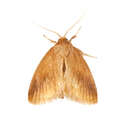Conservation Status
provided by University of Alberta Museums
Rarely collected in Alberta where they are at the northern edge of their range.
- license
- cc-by-nc
- copyright
- University of Alberta Museums
Cyclicity
provided by University of Alberta Museums
Adults have been collected in Alberta in June.
- license
- cc-by-nc
- copyright
- University of Alberta Museums
Distribution
provided by University of Alberta Museums
Nova Scotia and New Brunswick west to southern BC, south to the Gulf of Mexico states. In Alberta it has been collected mainly along the eastern edge of the province, from north of Fort McMurray south to the Wainwright dunes area, and in the Peace River area.
- license
- cc-by-nc
- copyright
- University of Alberta Museums
General Description
provided by University of Alberta Museums
"A small (1.5-2.5 cm wingspan) broad-winged moth with rust or yellow-brown forewings and tan-tinted white hindwings. The forewings are essentially unmarked, with a diffuse slightly darker median band reaching the apex. The veins are all slightly darker and are visible against the ground. The hindwings are white with a very light tan tint, and with the brown fringe forming a narrow terminal band. In shape and size testacea resembles a small gemetrid moth, but the color and pattern will separate it, as will the different wing venation.
Tortricidia testacea is the only member of the family Limacodidae (Slug-catterpillar Moths) found in Alberta."
- license
- cc-by-nc
- copyright
- University of Alberta Museums
Habitat
provided by University of Alberta Museums
Deciduous woodland; urban plantations.
- license
- cc-by-nc
- copyright
- University of Alberta Museums
Life Cycle
provided by University of Alberta Museums
The caterpillars are short-legged and slug-like, and give the family their name, the slug-caterpillar moths. They are solitary defoliators of deciduous trees. In Alberta there is apparently a single brood each year, with the adults emerging in June. The adults are attracted to light.
- license
- cc-by-nc
- copyright
- University of Alberta Museums
Trophic Strategy
provided by University of Alberta Museums
No Alberta data; elsewhere a variety of hardwoods have been reported as hosts, including oak (Quercus), beech (Fagus), birch (Betula), chestnut (Castanea), wild cherry (Prunus), hickory (Carya) and Mountain alder (Alnus). (Handfield, 1999; Prentice, 1965).
- license
- cc-by-nc
- copyright
- University of Alberta Museums
Tortricidia testacea
provided by wikipedia EN
The warm-chevroned moth (Tortricidia testacea) is a moth of the family Limacodidae. It is found from Nova Scotia west and south to Manitoba, Missouri and Mississippi. There is also a record from South Carolina.
The wingspan is 15–26 mm. Adults are on wing from April to August.
The larvae feed on beech, birch, black cherry, chestnut, oak and witch-hazel.
See also
References

- license
- cc-by-sa-3.0
- copyright
- Wikipedia authors and editors
Tortricidia testacea: Brief Summary
provided by wikipedia EN
The warm-chevroned moth (Tortricidia testacea) is a moth of the family Limacodidae. It is found from Nova Scotia west and south to Manitoba, Missouri and Mississippi. There is also a record from South Carolina.
The wingspan is 15–26 mm. Adults are on wing from April to August.
The larvae feed on beech, birch, black cherry, chestnut, oak and witch-hazel.
- license
- cc-by-sa-3.0
- copyright
- Wikipedia authors and editors

